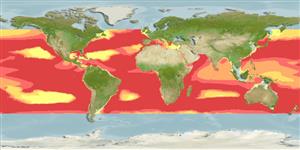Environment: milieu / climate zone / depth range / distribution range
Écologie
marin bathypélagique; océanodrome (Ref. 51243); profondeur 90 - 1485 m (Ref. 104125). Deep-water; 55°N - 46°S
Eastern Atlantic: British Isles to Namibia, also the Mediterranean (gap across region of cyclonic gyre between the South Equatorial Countercurrent and western branch of Benguela Current (5°S-13°S). Larvae, however, are not found among the cruise collections in the Agulhas Current Region (Ref. 41388). Western Atlantic: off Suriname to Brazil (Ref. 13608). Northwest Atlantic: Canada (Ref. 5951). Indian Ocean: 0°-40°S. Western Pacific: Australia (Ref. 7300). Eastern Pacific: 42°-25°N, 5°-20°S and west of 80°W. Recorded from off Tungkang in Taiwan and Tungsha Islands in South China Sea (Ref. 39633).
Length at first maturity / Taille / Poids / Âge
Maturity: Lm 5.8, range 6 - ? cm
Max length : 8.4 cm SL mâle / non sexé; (Ref. 126117); poids max. publié: 16.10 g (Ref. 126117); âge max. reporté: 1.50 années (Ref. 31516)
Épines dorsales (Total) : 0; Rayons mous dorsaux (Total) : 12 - 15; Épines anales: 0; Rayons mous anaux: 18 - 20; Vertèbres: 32 - 34. Branchiostegal rays: 7-9 (Ref. 31442).
Oceanic, found between 225-750 m during the day and between 90-375 m (juveniles) and 450-550 m (adults) at night. Epipelagic to mesopelagic (Ref. 31442). Widespread distribution in all oceans, limited by 10° and 15°C isotherms at 200 m and by a productivity greater than 50g Carbon per square meter per year. Sexually mature from about 5.9 cm. Spawn mainly during summer to autumn in the Mediterranean (Ref. 4775). Oviparous, with planktonic eggs and larvae (Ref. 31442). Also Ref. 58302.
Oviparous (Ref. 31442), determinate fecundity (Ref. 104737).
Hulley, P.A., 1990. Myctophidae. p. 398-467. In J.C. Quero, J.C. Hureau, C. Karrer, A. Post and L. Saldanha (eds.) Check-list of the fishes of the eastern tropical Atlantic (CLOFETA). JNICT, Lisbon; SEI; Paris; and UNESCO, Paris. Vol. 1. (Ref. 4479)
Statut dans la liste rouge de l'IUCN (Ref. 130435)
Menace pour l'homme
Harmless
Utilisations par l'homme
Outils
Articles particuliers
Télécharger en XML
Sources Internet
Estimates based on models
Preferred temperature (Ref.
123201): 5.4 - 14.9, mean 10.1 °C (based on 1190 cells).
Phylogenetic diversity index (Ref.
82804): PD
50 = 0.5312 [Uniqueness, from 0.5 = low to 2.0 = high].
Bayesian length-weight: a=0.01230 (0.00690 - 0.02192), b=3.09 (2.93 - 3.25), in cm total length, based on LWR estimates for this species & (Sub)family-body (Ref.
93245).
Niveau trophique (Ref.
69278): 3.4 ±0.45 se; based on food items.
Résilience (Ref.
120179): Haut, temps minimum de doublement de population inférieur à 15 mois (K=3.03; tmax=1.5).
Fishing Vulnerability (Ref.
59153): Low vulnerability (10 of 100).
Nutrients (Ref.
124155): Calcium = 172 [54, 509] mg/100g; Iron = 0.912 [0.350, 2.904] mg/100g; Protein = 16.1 [14.2, 18.0] %; Omega3 = 0.344 [0.128, 0.907] g/100g; Selenium = 23.7 [7.4, 71.7] μg/100g; VitaminA = 35.7 [4.7, 258.7] μg/100g; Zinc = 1.05 [0.53, 2.25] mg/100g (wet weight);
